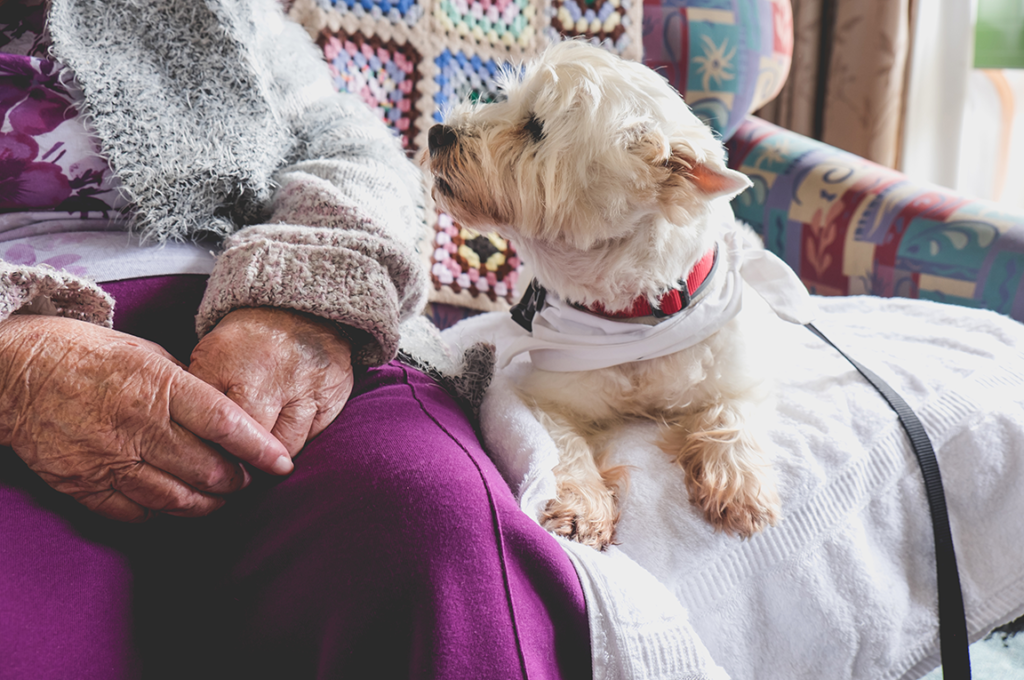By Phyllis Ventocilla, LMSW
Can a gentle purr or friendly tail wag really help seniors live happier, healthier lives? Current research renders a resounding yes! This may be especially pertinent for older adults who typically have enjoyed a long relationship with their pets. Pet therapy, also known as animal assisted therapy, offers many physiological and emotional benefits and can enhance a sense of community within long term care residences.

Another study, conducted with older adults with dementia, demonstrated pet therapy was helpful in several ways (Richeson, 2003). Restlessness, particularly at the end of the day, can be problematic for those with Alzheimer’s. Regular visits with trained therapy dogs in this study led to a measurable decrease in wandering and restless behaviors in participants during the study. Residents with dementia also struggle with social interaction as the disease progresses. Participants with dementia demonstrated an increased number and duration of social interaction following animal therapy visits.
Trained therapy dog visits can also improve physical health. In a study at UCLA medical center (Gawlinski & Steers, 2019) hospitalized patients with heart failure received a 12 minute visit where the dog may lay on the bed with the patient, and they could touch and talk to the animal. These interactions resulted in lowered blood pressure and decreased levels of stress hormones following the visit. In addition, pet visits reduced anxiety levels by 25% among participants.
Pet therapy can also increase a sense of community in assisted living residences. Pet friendly homes often see residents gathered around to pet the puppy or start a conversation with the owner. In skilled facilities with bird sanctuaries, residents gather to watch the beauty of finches in flight, or to hear the hypnotic chirping of these charming birds, drawing residents out of their rooms and into common living spaces.
In Atul Gawande’s book, Being Mortal, he describes a program called the Eden Alternative, initiated by Bill Thomas at Chase Memorial Nursing Home. A variety of pets and live plants took up residence at the facility and residents assumed care for many of them. Gawande describes the transformative impact this project had on the residents, where they began to assume responsibility for the animals, and they became much more social. Gawande talks about the importance of a sense of loyalty and purpose in our lives and that pets can fill this need in a significant way, contributing to overall wellbeing.
As part of the Harbor Hospice Pet Therapy program, volunteers bring trained pet therapy dogs to visit residents, providing them time to pet and companion with the dog. During these visits folks will often reflect affectionately on memories of dogs or cats they owned earlier in their lives. Residents speak with great affection of their canine visitors and eagerly anticipate the next visit. Most telling, they often may not recall the name of the volunteer, but the dog’s name is rarely forgotten.
Clearly, for older adults, pet therapy provides physiological, social, and emotional benefits that go hidden in a gentle touch or a “Good Boy”!
The Effects of Animal-Assisted Therapy on Loneliness in an Elderly Population in Long-Term Care Facilities
Marian R. Banks, William A. Banks
The Journals of Gerontology: Series A, Volume 57, Issue 7, 1 July 2002, Pages M428–M432
https://academic.oup.com/biomedgerontology/article/57/7/M428/553460
Dogs ease anxiety, improve health status of hospitalized heart failure patients
American Heart Association Abstract 2513 (Download PDF)
https://www.uclahealth.org/pac/Workfiles/volunteering/PACArticle.pdf
Co-authors are Anna Gawlinski, R.N., D.N.Sc., and Neil Steers, Ph.D.
Effects of animal-assisted therapy on agitated behaviors and social interactions of older adults with dementia
Nancy E. Richeson, PhD, CTRS American Journal of Alzheimer’s Disease and Other Dementias
https://journals.sagepub.com/doi/pdf/10.1177/153331750301800610
Gawande, Atul Being Mortal Medicine and What Matters in the End (2014)
Article published in Senior Perspectives May-June 2020 Issue (distributed and published by Senior Resources)
About the author
Phyllis Ventocilla has been a Social Worker with Harbor Hospice for 3 years, and is a Licensed Masters Social Worker. Prior to Harbor Hospice, Phyllis worked for 12 years in her social work profession with children and families. She has a Master’s in Social Work from Michigan State University, loves dogs, and says her family’s Havanese dog, Chuck, is their favorite pet therapist!
